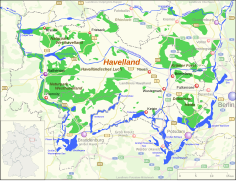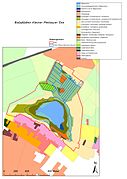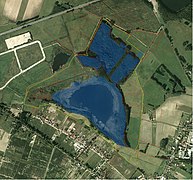Little Plessower See
| Little Plessower See | ||
|---|---|---|

|
||
| At the Kleiner Plessower See | ||
| Geographical location | Central Europe , Germany , Brandenburg , | |
| Tributaries | fed by at least 2 active sources | |
| Drain | 2 drains into the Großer Plessower See | |
| Places on the shore | Werder / Havel | |
| Data | ||
| Coordinates | 52 ° 23 '24 " N , 12 ° 51' 47" E | |
|
|
||
| Altitude above sea level | 23 m above sea level NHN | |
| surface | 32 ha | |
| length | 500 m | |
| width | 480 m | |
| Maximum depth | 4.5 | |
| Middle deep | 1.2 m | |
|
particularities |
Groundwater lake, clear water lake; Mud deposits (mud) up to 30 m thick on the south-western bank |
|
The Kleine Plessower See is located near Werder an der Havel in the Potsdam-Mittelmark district about 15 km west of Potsdam , west of the municipality of Plessow . It is inaccessible between the Bundesautobahn 10 , the Bundesstrasse 1 and the Großer Plessower See . The neighboring village is Neu Plötzin .
geography
The lake is part of the nature reserve (NSG) Kleiner Plessower See in the Brandenburg Havel lowlands. As a wetland with a shallow lake and calcareous silting and spring moors as a bank area, the NSG has a total area of 104 ha. Part of this area is owned by the NABU Foundation for National Natural Heritage. Large areas of fen soils have formed around the lake when, since the Middle Ages, a mill damming in Brandenburg flooded the lowland for months every year. Today the wet meadows are used for pasture farming. The lake has wide silting zones with reed beds, sedge beds and alder forests.
Early settlement
In the area of Kemnitz on the north bank of the Großer Plessower See in Vogelsangheide there is one of the largest burial places of the Semnonen with over 1000 sites from the 1st to 4th centuries. Century AD In addition to weapons and Roman metal vessels, gold and silver were also found. Slavic settlers (Wenden) reached this area around the year 700 AD. By mixing the remaining Teutons, who called the Havel Habula, the tribal name Heveller was created in New High German, from which the current name Havel was derived.
geology
Like almost all of Brandenburg's lakes, the Kleine Plessower See is a testament to the last ice age. Such lakes were created by the erosion of glacier tongues or as so-called channel lakes in the runoffs of ice age meltwater. Countless lakes, especially smaller ones, fill hollow forms that remained after the ice sheet retreated and later left behind melted blocks of dead ice. Shallow lakes were created where groundwater that rose after the Ice Age filled small and large depressions in the terrain.
Hydromorphology
The Kleine Plessower See is a moderately calcareous clear water lake, which is still slightly eutrophic (nutrient-rich) in terms of nutrient supply due to agricultural use and the inflow from the adjacent basement moraine plate, but with a tendency to a mesotrophic status. The average water depth is 1.20 m, the deepest point is 4.50 m. The visibility depth in summer is 2 m, the bottom of the lake is musty. There is a gravel bank on the east side of the lake towards Plessow.
ecology
Clear water lakes are rare and extremely valuable habitats. They are subject to the protection of the Habitats Directive and have been comprehensively integrated into the European Natura 2000 protected area system in Brandenburg . All clear water lakes have one thing in common: they have a mostly very sparse reed belt made of reeds or rush edge ( Cladium mariscus ). In contrast, the underwater vegetation of chandelier algae and spawning herbs is often lush and, depending on the water depth, clearly structured from the shore. Macrozoobenthos, macrophytes and limnochemistry of the eutrophic shallow lake Kleiner Plessower See were investigated in 2002. The lake has remarkable flora and fauna, with numerous endangered species of water beetles and freshwater mollusks. In the year of the study, a phytoplankton-dominated stage was encountered, so that the submerged flora (e.g. Najas marina ssp. Intermedia , Utricularia vulgaris and U. minor ) was only found in rudimentary stands. However, the extensive reed beds and silt banks with initial stages of alder breakouts are of great importance.
The small Plessower See can be characterized as a tench-pike lake with a predominant population of tench, pike, eel, roach, rudd, perch. There is also evidence of the Moderlieschen and the three-spined stickleback. The bitterling ( Rhodeus amarus ), which is worthy of protection according to Annex II of the Habitats Directive, has also been proven and finds good conditions for reproduction due to the occurrence of pond mussels. The water is used for fishing in spring and autumn.
At z. T. rare birds are u. a. proven: Tasmanian titmouse, whinchat, bittern, bittern, bluethroat, red-backed killer, kingfisher, marsh harrier (breeds), crane (breeds), reed warbler, reed warbler, reed warbler, little grebe, barn warbler, reed and field owl. Birds of prey include: hawk and sea eagle. The latter is a frequent visitor and, according to experts, should probably settle here permanently. Noble dragonfly species such as the large and small royal dragonfly ( Anax imperator and parthenope ) and the blue-green Aeshna cyanea are also common. The NSG and its surroundings are an important resting place for migratory birds such as waxwing, gray and bean goose, forest goose, white-fronted goose, goosander, golden egret (in large numbers), and buzzard in the winter months.
Agricultural use takes place around the lake in the form of extensive pasture.
Hunting takes place mainly on small game, roe deer and wild boar.
natural reserve
With the ordinance (Protected Area Ordinance) of December 6, 2002, the Kleine Plessower See with its bank areas (a total of 104 ha) received the status of a nature reserve (NSG). Like most of the NSG, the NSG Kleiner Plessower See also has a significance as a fauna-flora-habitat area (FFH) and thus belongs to the European Natura 2000 system of protected areas. The lake is classified as habitat type 3140: oligo-mesotrophic calcareous still waters with benthic candlestick algae -Vegetation. Further FFH classifications for the entire NSG are 6430: Moist tall herbaceous corridors and 7210: Swamps and reeds with edges. Species worthy of protection according to Annex II of the FFH guidelines are Rhodeus amarus (bitterling), Anisus vorticulus (petite poppy snail), Vertico angustior (narrow diaper snail), Vertico moulinsiana (bellied diaper snail). The lake has remarkable flora and fauna with numerous endangered species of water beetles and freshwater mollusks. The occurrence of the large piston water beetle (are particularly noteworthy Hydrophilus piceus ), the Gauckler's ( Cybister lateralimarginalis ) and mollusks anisus spirorbis , anisus vorticulus , Gyraulus acronicus , Gyraulus riparius , Marsh gills screw ( Valvata macrostoma ) hibernicum Pisidium and pseudosphaerium Pisidium . Plants worth protecting are u. a. Chandelier algae, spawning herbs, mermaid and water hose communities, rush blade ( Cladium mariscus ), Caricion davallianae , crayfish claws, cattails.
Monitoring
Faunistic and floristic surveys are carried out by the NABU conservation area supervisors, the results of which are reported to the Naturgucker portal.
photos
See also
- List of lakes in Brandenburg
- List of lakes in Germany
- List of nature reserves in the Potsdam-Mittelmark district
- List of FFH areas in Brandenburg
Web links
- State Office for Environment, Health and Consumer Protection (LUGV)
- Network for nature observers called on February 8, 2011
- 3643-301 Kleiner Plessower See. (FFH area) Profiles of the Natura 2000 areas. Published by the Federal Agency for Nature Conservation .
- Ministry of Environment, Health and Consumer Protection (MUGV) accessed on February 8, 2011
- Management planning in Natura 2000 areas PDF accessed on February 8, 2011
- Ministry of Environment, Health and Consumer Protection (MUGV) accessed on February 8, 2011
- Ministry of Environment, Health and Consumer Protection (MUGV) accessed on February 8, 2011
- Nature conservation in the PM district called on February 8, 2011
- Landscape master plan ( memento of August 7, 2011 in the Internet Archive ) PDF accessed on February 8, 2011
- Protected areas in Werder PDF accessed on February 8, 2011
Individual evidence
- ^ Protected area profile PDF accessed on February 8, 2011
- ↑ Project overview PDF accessed on February 8, 2011
- ↑ Ministry of Environment, Health and Consumer Protection (MUGV)
- ^ Contributions to the animal world
- ↑ Status of a nature reserve (NSG)
- ↑ Oligo- to mesotrophic calcareous still waters with benthic chandelier algae vegetation (Characeae). Habitat types of the European Natura 2000 system of protected areas . Retrieved March 14, 2017.
- ↑ Moist perennial edges of the planar to alpine altitude level including forest edges. Habitat types of the European Natura 2000 system of protected areas . Retrieved March 14, 2017.
- ↑ Calcareous swamps with Cladium mariscus and species of Caricion davallianae. Habitat types of the European Natura 2000 system of protected areas . Retrieved March 14, 2017.





